- Hole V-22-026 returned 1.25 g/t Au over 189.2 m from surface within a broader mineralized interval averaging 0.90 g/t Au over 289.7 m in 170 m step-out
- Hole V-22-027 returned 1.01 g/t Au over 250.0 m, within a broader mineralized interval averaging 0.69 g/t Au over 481.5 m
- Results extend strike length of the mineralized core of the Valley intrusion to southeast, adding significant tonnage to known mineralization
- Metallurgical testing of Valley drill core set to advance understanding of gold recovery and project economics
- Assays still pending for 13 of 32 holes (6,003 m of 13,320 m) drilled at Valley and Gracie in 2022
VANCOUVER, BC / ACCESSWIRE / January 18, 2023 / SNOWLINE GOLD CORP. (CSE: SGD)(OTCQB:SNWGF) (the "Company" or "Snowline") is pleased to announce additional preliminary assay results from its 2022 drilling program at the Valley Zone, Rogue Project, Yukon, and the commencement of metallurgical testing. Holes V-22-026 and V-22-027, drilled to the southeast of previously announced holes V-22-014 (285.2 m @ 1.45 g/t Au) and V-22-007 (410.0 m @ 1.89 g/t Au), extend the strike length of the near-surface, well-mineralized corridor at Valley by 172 m to at least 550 m (open). V-22-027 returned the longest mineralized intersection seen at Valley to date, with potential for higher grades immediately above this hole based on nearby results. Assays remain pending for 6,003 m of the 2022 Rogue drill program.
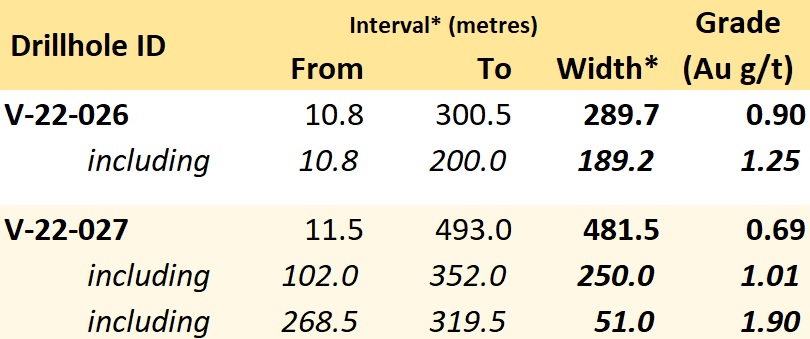
Table 1 - Preliminary highlight summary of Snowline's latest assay results. *Interval widths reported; true widths of the system are not yet known. **Results still pending for bottom 126.0 m of this hole.
"Each round of Valley drill results has increased not just to the known extent of mineralization at the target, but to our understanding of its geology and the geometry of its highest-grade zones," said Scott Berdahl, CEO & Director of Snowline. "The most robust and consistent mineralization we have seen so far at Valley begins in a broad zone at surface, lending itself to promising potential economics for the project, and reducing the drill metres required to advance the discovery. We eagerly await remaining 2022 drill assay results that will shed additional light on this substantial gold discovery. Our current metallurgical program will provide additional value in outlining gold recoverability, an important milestone as the project moves forward."

Figure 1 - 2021 and 2022 drilling at the Valley Zone, showing assays received to date (top) and vein densities alongside instances of visible gold observed during logging (bottom). Visual results indicate the presence of a large central zone within the broader Valley intrusion bearing higher vein densities. Initial analytical results for this zone consistently carry unusually high grades for a reduced intrusion-related gold system.
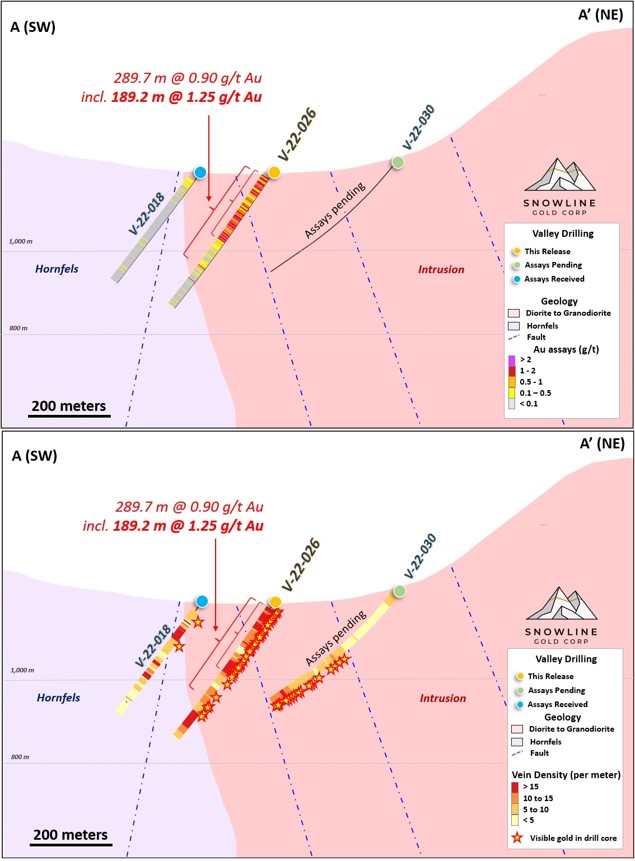
Figure 2 - Cross section A, showing results received (top) and vein densities alongside instances of visible gold observed during logging (bottom). V-22-026 is the southeasternmost drill hole to hit a broad zone of >1 g/t Au mineralization, extending the known strike length of the bulk tonnage gold system to >0.5km. Views look northwest.
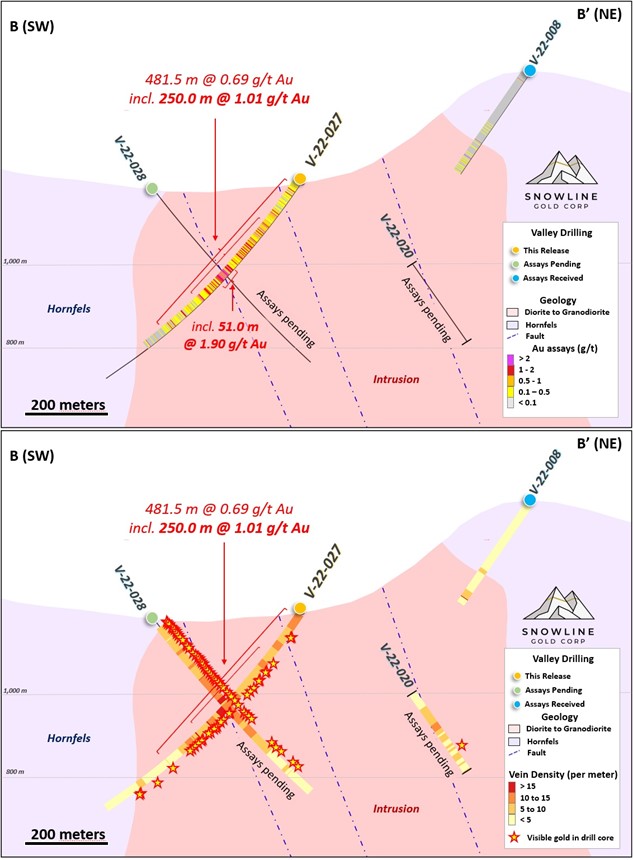
Figure 3 - Cross section B, showing results received (top) and vein densities alongside instances of visible gold observed during logging (bottom). V-22-027 was drilled to intersect the mineralized system at depth before grade distributions were known and may have cut under the highest-grade zone locally. Nonetheless, it encountered robust mineralization along most of its length. Views look northwest.

Table 2 - Summary of mineralization in current holes. G-22-002 is the first result from the Gracie target. The hole was called short of its target due to difficult drilling conditions and low levels of alteration. This hole was the only hole at Gracie not to encounter at least one trace instance of visible gold. *Interval widths reported; true widths of the system are not yet known. **Results still pending for bottom 126.0 m of this hole.
HOLE V-22-026
Hole V-22-026 was collared within the Valley intrusion, along strike with the intrusion's well-mineralized corridor and 172 m from the collar site for V-22-014 (285.2 m @ 1.45 g/t Au including 128.2 m @ 2.48 g/t Au, see Snowline news release dated November 15, 2022). The hole encountered moderate to dense quartz veins and abundant visible gold in its upper sections, returning 1.25 g/t Au over 189.2 m from bedrock surface at 10.8 m depth, within a broader interval returning 0.90 g/t Au over 289.7 m. The hole cut through the western margin of the intrusion and entered lightly mineralized (generally <0.1 g/t Au, with local hits up to 0.34 g/t Au over 1.5 m) hornfels at 314.8 m downhole.
The hole extends the known strike length of broad, near-surface, gram to multiple gram per tonne gold mineralization at Valley to >550 m from mineralization encountered in 2021 drilling. This zone of mineralization remains open in multiple directions.
As with previous holes at Valley, gold grades are carried across broad intervals, and they are not heavily affected by local high-grade (>10 g/t Au) intersections (Table 2).
HOLE V-22-027
Hole V-22-027 was collared in the Valley intrusion as a step back to the northeast to test the well-mineralized central corridor between holes V-22-014 and V-22-026 at depth. The hole encountered widespread light to dense quartz vein mineralization from surface bearing bismuthinite and visible gold, before exiting the western boundary of the intrusion into hornfels at 594 m downhole depth.
Analytical results for the top 551 m of 677 m total have been received at this time. Local zones of up to 1.90 g/t Au over 51.0 m (from 268.5 m downhole) were encountered, within a wide zone of moderate to strong mineralization averaging 1.01 g/t Au across 250.0 m from 102.0 m downhole. More broadly, mineralization at grades >0.1 g/t Au is nearly continuous from 11.5 m to 493.0 m downhole, averaging 0.69 g/t Au over the 481.5 m interval and making for the longest continuously mineralized intersection (no gaps >4.5 m at <0.1 g/t Au) at the bulk tonnage Valley deposit to date. Local zones of mineralization occur below this interval, and the company awaits analytical results for the final 126 m of the hole.
Results from surrounding holes, including V-22-007 and V-22-014, suggest that the trace of V-22-027 would have passed underneath the southwestern extension of the near-surface, multiple-gram-per-tonne gold zone encountered in those holes. Drilling in 2023 will test shallower parts of this area.
METALLURGICAL TESTING
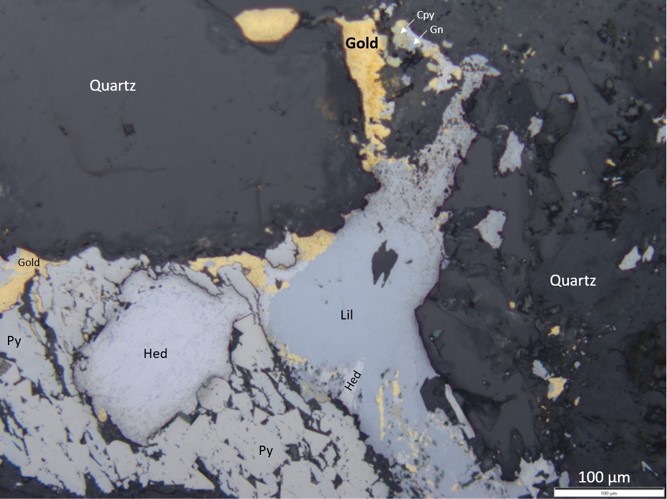
Figure 4 - Reflected light micrograph of abundant gold grains in V-22-007 at 269.8 m downhole. Gold occurs primarily in its native form, as fine grains along grain boundaries near small clusters of sulphides minerals in quartz veins. Snowline has initiated metallurgical testing of the Valley gold system to determine recovery parameters and processing options. Scale bar (bottom right) shows 100 microns, or 0.1 mm. Py=Pyrite (FeS2), Cpy=Chalcopyrite (CuFeS2), Gn=Galena (PbS), Hed=Hedleyite (Bi7Te3), Lil=Lillianite (Pb3Bi2S6).
Initial metallurgical testing of drill core from the Valley gold system is set to begin following shipping of sample material to a third-party lab. The metallurgy program will see 10 continuous composite samples of approximately 10 kg each-representing different parts of and different gold grades within the Valley intrusion-undergo head analysis, bottle roll tests and rougher flotation tests to establish potential gold recoveries for the system and relative suitability of certain potential means of ore processing.
Overall sulphur content of mineralization in Valley is low, typically <0.5% in well-mineralized zones. This, along with the distribution of abundant visible gold, is encouraging from a metallurgical perspective. Comparisons to gold systems with similar styles of mineralization, including Kinross's Ft Knox Mine in Alaska and Victoria Gold's Eagle Mine in the Yukon, provide further evidence that good recoveries and favourable metallurgy are likely at Valley. Each mineral system is unique, however, and thus for greater certainty, the Company is undertaking the present study.
QA/QC
On receipt from the drill site, Valley's NQ2-sized drill core was systematically logged for geological attributes, photographed and sampled at Snowline's 2022 field camp. Sample lengths as small as 0.5 m were used to isolate features of interest, otherwise a default 1.5 m downhole sample length was used. Core was cut in half lengthwise along a pre-determined line, with one half (same half, consistently) collected for analysis and one half stored as a record. Standard reference materials, blanks and duplicate samples were inserted by Snowline personnel at regular intervals into the sample stream. Bagged samples were sealed with security tags to ensure integrity during transport. They were delivered by expeditor and by Snowline personnel to ALS Laboratories' preparatory facility in Whitehorse, Yukon, with analyses completed in Vancouver.
ALS is accredited to ISO 17025:2005 UKAS ref 4028 for its laboratory analysis. Samples were crushed by ALS to >70% passing below 2 mm and split using a riffle splitter. 250 g splits were pulverized to >85% passing below 75 microns. A four-acid digest with an inductively coupled plasma mass spectroscopy (ICP-MS) finish was used for 48-element analysis on 0.25 g sample pulps (ALS code: ME-MS61L). All samples were analysed for gold content by fire assay with an atomic absorption spectroscopy (AAS) finish on 30 g samples (ALS code: Au-AA23). Any sample returning >10 g/t Au was reanalysed by fire assay with a gravimetric finish on a 30 g sample (ALS code: Au-GRA21).
Samples with visible gold and other samples returning >2.0 g/t Au by fire assay, along with a set of randomly selected samples, will undergo further processing, analysing the screen rejects to determine whether the screening process could introduce a sampling bias in current results by excluding coarse gold from analysis, resulting in an under-reporting of true grades. Other biases are also possible.
Results reported herein are considered preliminary following receipt of a low but expected percentage of abnormal assays from standard and blank samples inserted by the Company into the Valley sample stream. (Standard samples are prepared by a third-party laboratory to have known quantities of gold, and blank samples are known to contain very limited concentrations of gold.) Reanalysis of samples run along with these reference materials will provide greater certainty in the final assay numbers. These results will be reported if a material difference is identified between the current assays and the re-run sample batches. Based on the widespread and relatively consistent mineralization throughout mineralized zones, however, the Company does not believe that the re-analysis of this relatively small number of samples will have a significant impact on the preliminary mineralized intervals reported herein.
ABOUT ROGUE
Rogue's Valley Zone is a newly discovered, bulk tonnage style, reduced intrusion-related gold system (RIRGS), with geological similarities to multi-million-ounce deposits currently in production like Kinross's Fort Knox Mine in Alaska and Victoria Gold's Eagle Mine in the Yukon. Early drill results demonstrate unusually high gold grades for such a system present near surface across intersections of hundreds of metres. Gold is associated with bismuthinite and telluride minerals hosted in sheeted quartz vein arrays along the margins of and within a one-kilometer-scale, mid-Cretaceous aged Mayo-series intrusion. Valley is an early-stage exploration project without a resource estimate, and while initial results are encouraging, the presence or absence of an economically viable orebody cannot be determined until significant additional work is completed.
The Rogue Project area hosts multiple intrusions similar to Valley along with widespread gold anomalism in stream sediment, soil and rock samples. Elsewhere, RIRGS deposits are known to occur in clusters. The Rogue Project is thus considered by the Company to have district-scale potential for additional reduced intrusion-related gold systems.
ABOUT SNOWLINE GOLD CORP.
Snowline Gold Corp. is a Yukon Territory focused gold exploration company with a seventeen-project portfolio covering >280,000 ha. The Company is exploring its flagship >137,000 ha Rogue and Einarson gold projects in the highly prospective yet underexplored Selwyn Basin. Snowline's project portfolio sits within the prolific Tintina Gold Province, host to multiple million-ounce-plus gold mines and deposits including Kinross' Fort Knox mine, Newmont's Coffee deposit, and Victoria Gold's Eagle Mine. The Company's first-mover land position and extensive database provide a unique opportunity for investors to be part of multiple discoveries and the creation of a new gold district.
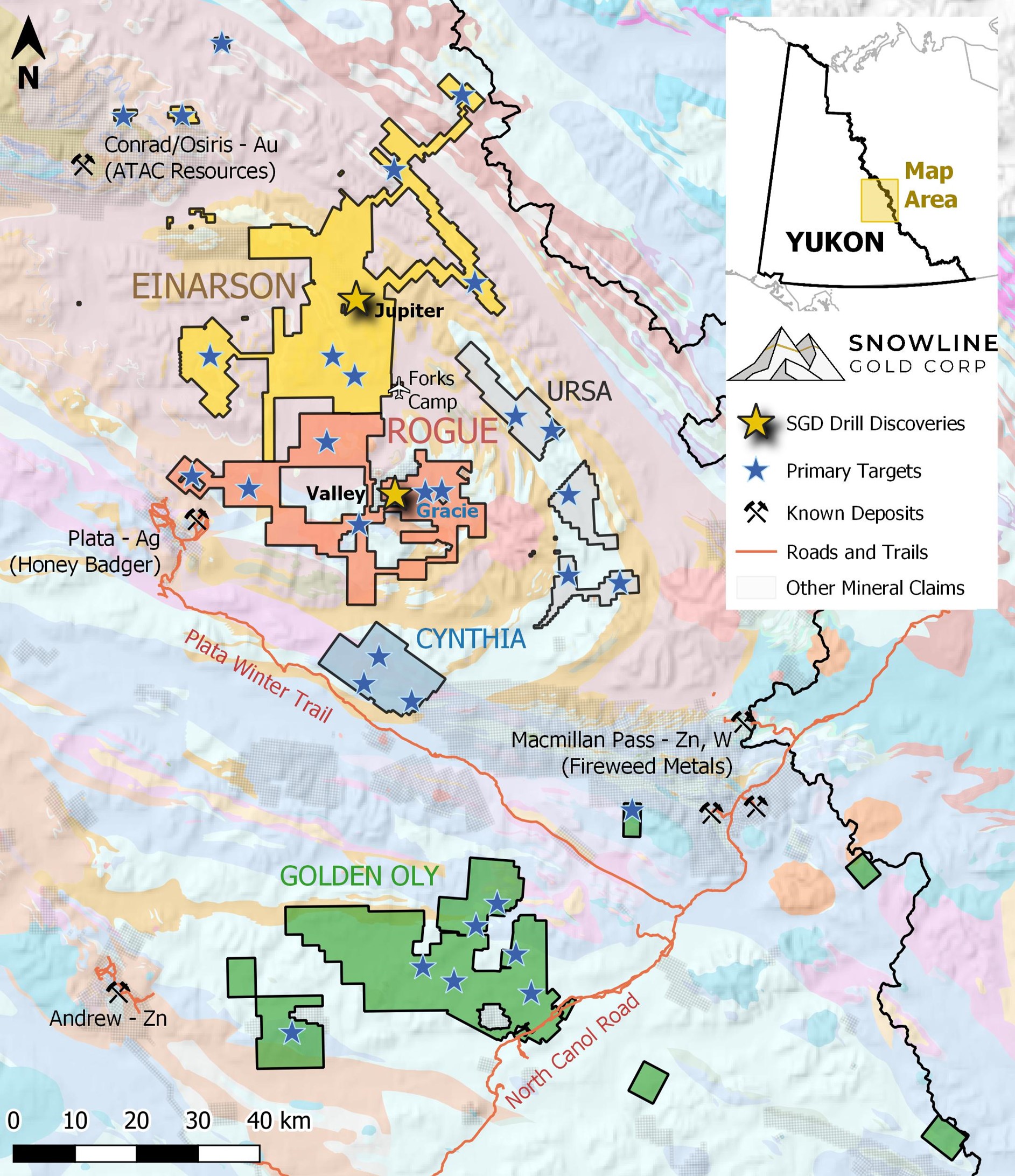
Figure 5 - Project location map for Snowline Gold's eastern Selwyn Basin properties. The Valley and Gracie Zones on the Rogue are the sites of Snowline's 2022 drill programs.
QUALIFIED PERSON
Information in this release has been prepared under supervision of and approved by Thomas K. Branson, M.Sc., P. Geo., Exploration Manager for Snowline and a Qualified Person for the purposes of National Instrument 43-101.
ON BEHALF OF THE BOARD
Scott Berdahl
CEO & Director
For further information, please contact:
Snowline Gold Corp.
+1 778 650 5485
info@snowlinegold.com
CAUTIONARY NOTE REGARDING FORWARD-LOOKING STATEMENTS
This news release contains certain forward-looking statements, including statements about the Company's drill program, results, implied significance of visual inspection of drill core, and surface work and plans for exploring and expanding a new greenfield, district-scale gold system. Wherever possible, words such as "may", "will", "should", "could", "expect", "plan", "intend", "anticipate", "believe", "estimate", "predict" or "potential" or the negative or other variations of these words, or similar words or phrases, have been used to identify these forward-looking statements. These statements reflect management's current beliefs and are based on information currently available to management as at the date hereof.
Forward-looking statements involve significant risk, uncertainties and assumptions. Many factors could cause actual results, performance or achievements to differ materially from the results discussed or implied in the forward-looking statements. Such factors include, among other things: risks related to uncertainties inherent in drill results and the estimation of mineral resources; and risks associated with executing the Company's plans and intentions. These factors should be considered carefully, and readers should not place undue reliance on the forward-looking statements. Although the forward-looking statements contained in this news release are based upon what management believes to be reasonable assumptions, the Company cannot assure readers that actual results will be consistent with these forward-looking statements. These forward-looking statements are made as of the date of this news release, and the Company assumes no obligation to update or revise them to reflect new events or circumstances, except as required by law.
SOURCE: Snowline Gold Corp.
View source version on accesswire.com:
https://www.accesswire.com/735661/Snowline-Gold-Intersects-1892-M-Of-12-Grams-Per-Tonne-Gold-Near-Surface-In-170-M-Step-Out-and-Commences-Metallurgical-Testing-at-Its-Valley-Discovery-Rogue-Project-Yukon




